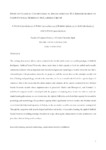Study of classical conditioning in Aplysia through the implementation of computational models of its learning circuit

Use este enlace para citar
http://hdl.handle.net/2183/16101Colecciones
- Investigación (FIC) [1687]
Metadatos
Mostrar el registro completo del ítemTítulo
Study of classical conditioning in Aplysia through the implementation of computational models of its learning circuitFecha
2007-07-04Cita bibliográfica
A. Santos , A. Porto , J. Romero , A. Albó & A. Pazos, 2007, Study of classical conditioning in Aplysia through the implementation of computational models of its learning circuit. Journal of Experimental & Theoretical Artificial Intelligence, 19 (2) : 119–158
Resumen
The learning phenomenon can be analysed at various levels, but in this
paper we treat a specific paradigm of artificial intelligence, i.e. artificial
neural networks (ANNs), whose main virtue is their capacity to seek
unified and mutually satisfactory solutions which are relevant to
biological and psychological models. Many of the procedures and
methods proposed previously have used biological and/or psychological
principles, models, and data; here, we focus on models which look for a
greater degree of coherence. Therefore we analyse and compare all
aspects of the Gluck–Thompson and Hawkins ANN models. A multithread
computer model is developed for analysis of these models in order
to study simple learning phenomena in a marine invertebrate (Aplysia
californica) and to check their applicability to research in psychology and
neurobiology. The predictive capacities of the models differs significantly:
the Hawkins model provides a better analysis of the behavioural
repertory of Aplysia on both the associative and the non-associative
learning level. The scope of the ANN modelling technique is broadened
by integration with neurobiological and behavioural models of
associative learning, allowing enhancement of some architectures and
procedures that are currently being used.
Palabras clave
Learning
Classical conditioning
Computational models
Multithread
Classical conditioning
Computational models
Multithread
Descripción
“This is an Accepted Manuscript of an article published by Taylor & Francis in Journal of Experimental & Theoretical Artificial Intelligence on 04 Jul 2007, available online: http://wwww.tandfonline.com/DOI:10.1080/09528130601052177.”
Versión del editor
ISSN
1362-3079





